Eliminating Silos: How Flowtrace Can Improve Cross-Team Collaboration
Eliminating silos improves collaboration, and productivity. Flowtrace helps you by providing metrics on collaboration, resulting in better...
Without collaboration, there would be no innovation. Learn how to measure cross-functional collaboration, and how you can improve your organisation!
Without collaboration, there would be no innovation.
And while most employees and leaders recognise the value of working together towards a shared vision, finding the time and best processes can prove extremely difficult.
It's not enough to put all of your star players in one room and hope they will work it out. In most cases, individual skills matter less than the overall attitude and environment the people are in.
“Who is on a team matters less than how the team members interact, structure their work, and view their contributions.” - Julia Rozovsky, Analyst, Google People Operations
Read on to learn the benefits of collaboration, how we measure collaboration and teamwork in Flowtrace, and how you can be more collaborative as an individual contributor or a leader at your organisation!
Put simply, collaboration means working with other employees, teams, departments, or even other organisations to accomplish a shared goal.
But while it may be simple to collaborate on a quick task, deep and meaningful collaboration takes practice and skill.
You need to know the different ways your teams work and find ways to bring them together amidst all the noise and distractions.
If we imagine the perfect workday, it would have:
There are plenty of reasons to measure and improve collaborative efforts for employees and leadership teams alike.
For individual contributors, collaboration can help boost motivation, broaden their skillset, provide networking opportunities, and increase overall job satisfaction. It's an opportunity to work with someone new, become more open-minded, and find ways of approaching the same problem from a new perspective.
For leaders and businesses, collaboration boosts sharing knowledge and resources while generating innovative ideas and increasing profitability. By having strong leadership and a team with complementary skills, companies can design better, more inclusive products of a higher quality that are also executed more effectively.
Different perspectives spur innovation. Old playbooks, methods, and systems are challenged and improved upon when we open up and work with others.
When there's too little collaboration between teams, the quality of work suffers and it causes undue friction. If goals (like OKRs) are misaligned, it causes teams to work towards different directions, and this is not feasible.
Without collaboration, misaligned goals will cause friction, unmet expectations, and a huge amount of frustration. But if there's too much collaboration, you'll enter decision paralysis, and there will be no time to accomplish real work.
Keeping a healthy balance between emailing, instant messaging, video calls, and face-to-face meetings is difficult without a tool like Flowtrace.
With our deep work analytics, you can benchmark how your teams differ by the way they collaborate. You can also stay on top of trends and get notified about deviations, so you can take corrective action before any potential issues escalate.
There are multiple areas where you can find valuable insights into how your teams collaborate cross-functionally and internally. Below are four reports we recommend starting with.
Get a complete overview of your team's work patterns in your dashboard's 'Activity Overview' area. Here, you'll see how your teams spend their average workday, including different activities by the number of hours:
You can also head to the Team Productivity report to get a more detailed view of each team's levels of activity and how they spend their workday.
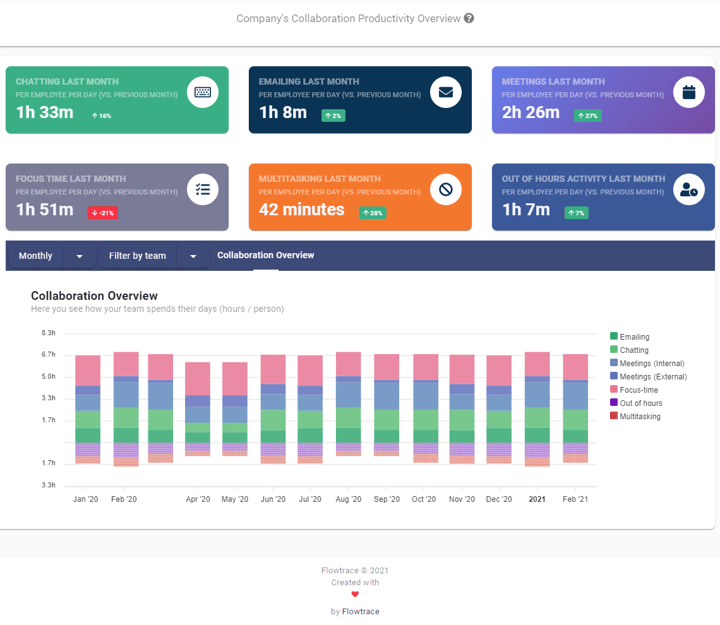
Team Productivity benchmarking report in Flowtrace.
With our 'Relational Network' map, you can get an overview of how your teams communicate with each other. You can quickly see which departments have a stronger relationship and how often they speak ranging from infrequent to occasional and frequent communication.
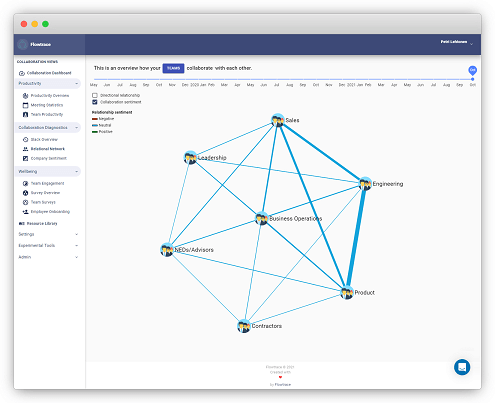
Team Relational Network map in Flowtrace.
Meetings make up a considerable part of a knowledge worker's day, and while some are essential to the growth of the business, some can be replaced with better information flows.
Our 'Meeting Statistics' report includes meeting frequency, invitees and attendees, agendas, and even the monetary investment estimate. This data gives you a birds-eye view of the meeting quality happening at your company.
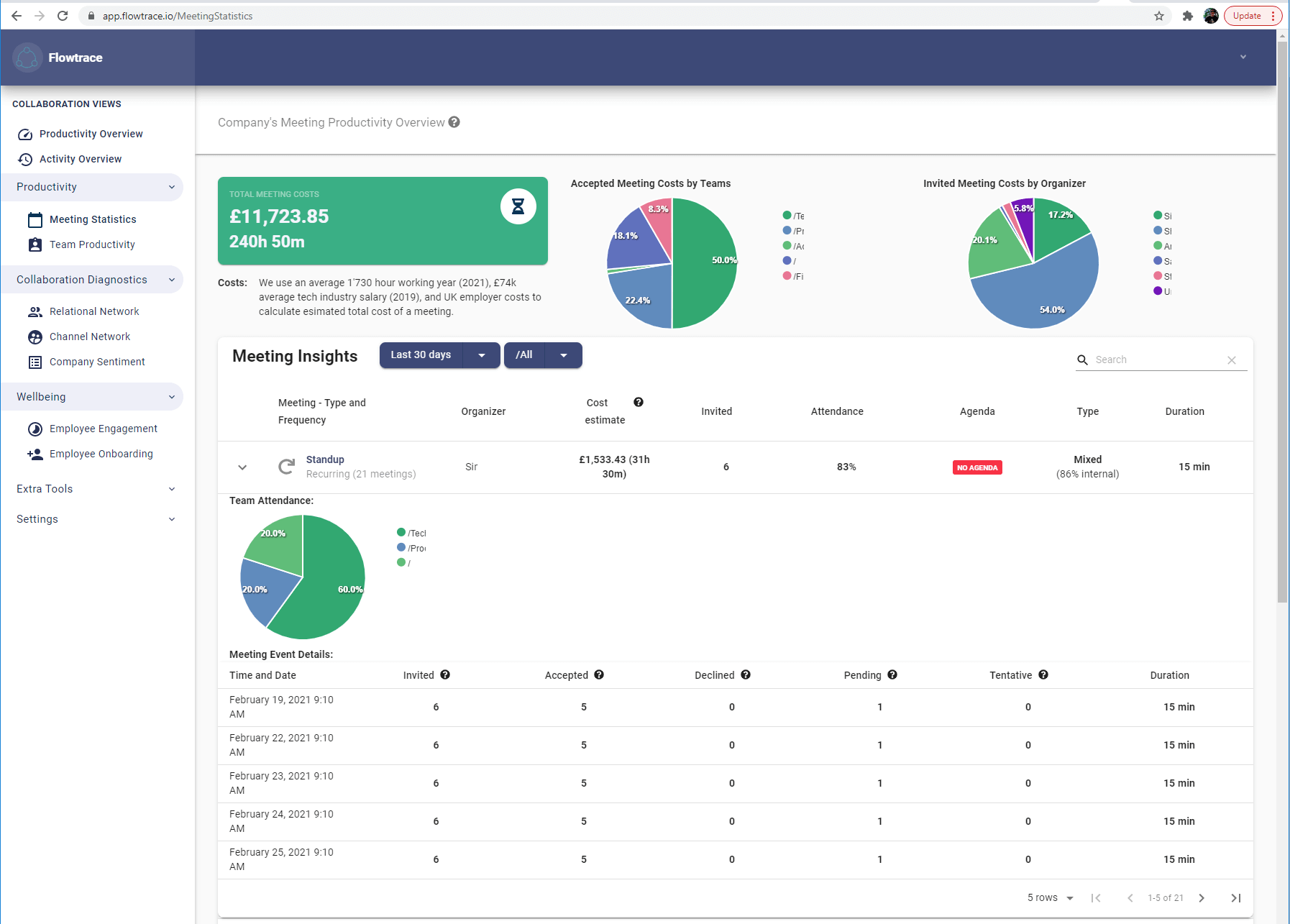
Meeting Productivity Overview report in Flowtrace.
Our Slack app is a handy companion for companies championing cross-team collaboration. This integration provides insights that go a level beyond the built-in Slack channel analytics and are useful for individuals as well as leaders.
Like our team reports within Flowtrace, this helpful Slack integration provides personalised metrics to help you better understand how your average workday is split. This information is private and most valuable to those who want to play an active role in improving their contributions at work.
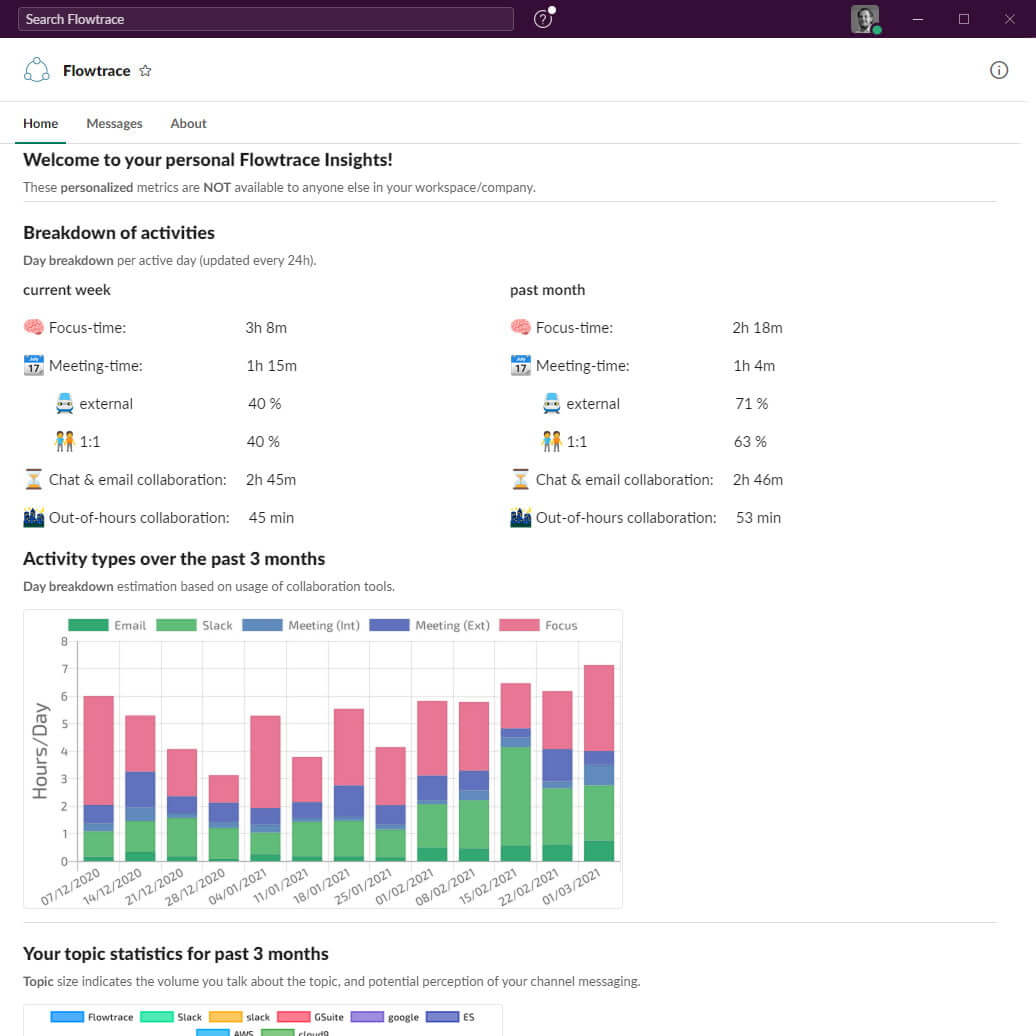
Individual, private metrics report in Flowtrace's app for Slack.
If you want to get better at collaboration, dive into these useful resources.
Need a refresher on the importance of collaboration? Click here to go up.
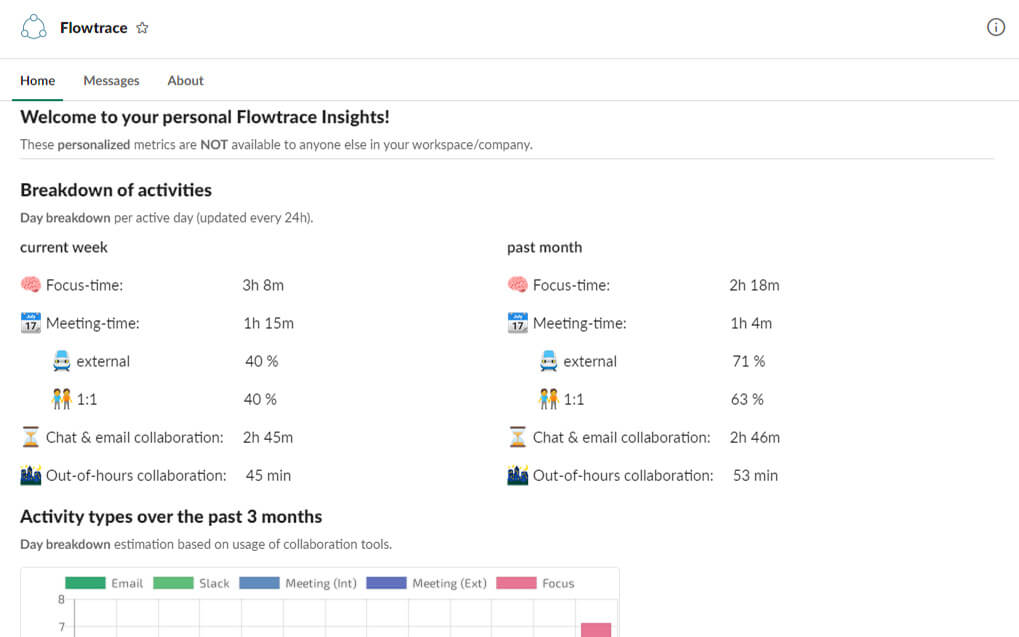
When it comes to collaboration as an individual contributor, it's essential you know you're doing the work that matters the most, armed with the right information while understanding why you're doing it.
But if your organisation lacks transparency and good communication, it can be tough to find the best time and resources to kick-start meaningful projects with other teams.
Meetings disrupt the regular flow of work, and while they get multiple people in the same room to discuss an issue, they can be a big waste of time without a clear agenda. When you schedule meetings, be mindful of who actually needs to be there. Only include key decision-makers and mark everyone else's attendance as optional. You can also make a habit of recording your meetings to make it easier for team members in other time zones.
When you do have meetings, make sure you make the most of your collaboration time. Instead of discussing the task, take a more practical approach and do the prep beforehand. Share the meeting plan as early as possible and emphasise the desired outcome for the event, complete with clear guidance on what the deliverables are with assigned owners.
We need uninterrupted time and space to enter deep work, but we also need to work together with others to drive purposeful projects forward. Balancing both requires skill. You need to intentionally decide on how much time you spend on collaborating with others and how much focus time you carve out for yourself.
Manager ReadMes (a.k.a. 'How to work with me' guides) may be most popular among leaders, but they are just as useful for individual contributors. This public document usually includes details on your average workweek, role, and preferred communication methods (from day-to-day to emergencies). You can also add notes on how you like to give and receive feedback, what you value, your approach to 1:1s, upcoming projects, and so on.
Even if you believe in working together with a passion, you or your team members may get into a conflict over how you think the project should be run. Sharing big responsibilities can be challenging, especially between clashing personalities. Improve your problem-solving skills by keeping cool in such situations. Cultivate enthusiasm for the ideas of others, and don't be afraid to show vulnerability to better manage your defensiveness.
Need a refresher on the importance of collaboration? Click here to go up.
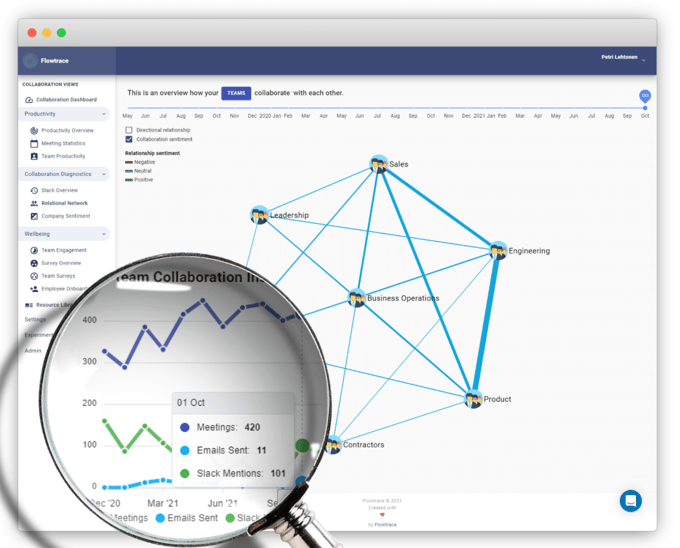
As a leader, you know that the only way to increase profitability and drive innovation forward is to get different teams to work together. But achieving effective cross-team collaboration truly is an art.
When there's too much collaboration, you get paralysed by too many options and decisions you need to make.
And when there's too little, teams get siloed, agendaless meetings prevail, and there is too much work about work, causing confusion.
To fix the imbalance, you need to know which way to go, but improving the quality and organisation of how teams collaborate is a good start either way.
Create your own meeting etiquette. Highlight what makes for an effective meeting and explain how the cost of ineffective meetings is much higher than that 15-minute check-in. Every session should have an agenda and clear takeaway points as standard, and you should try limiting recurring and status update meetings as much as possible. A quick tip: Before rolling out globally, try the new process with the leadership team first.
Endless email chains and a lack of visibility into work being done by teams can seriously damage the prospects of finishing a project. But working off outdated information can be equally frustrating! Do what you can to store all essential work in one public place - potentially, a project management tool. Kick it up a notch by making overarching business goals and objectives visible, seeking input, and sharing outcomes as they're reached. If you can, make a record of the crucial decisions being made and what alternatives were considered.
Cross-team collaboration is challenging, and you need to make sure that when different departments work together, there's a straightforward way that can be done. This starts from defining the process of requesting work items to avoid last-minute requests on Slack with no record or visibility, which can cause a lot of stress and, potentially, burnout. For common task handovers, follow the 80/20 rule and have a well-defined process for most of the work that's anticipated. Make tasks public and share them in team channels. Discourage employees from working off long email chains and convert them into proper tasks instead.
Are you building a super-marketable new feature? Or, are you revamping the way you onboard higher tier customers? Both are opportunities to get multiple teams to collaborate on the same project that's too difficult to tackle alone. Bring forward problems and ask how each team can contribute while focusing on the areas of their expertise. Tie in company goals, individual KPIs, and laser-sharp requirements as part of the planning process.
No one thinks sitting on Slack all day, in fight or flight response mode, is a productive way to spend their time, but we do it anyway because of the fear of missing out (FOMO). Stress the importance of limiting notifications and disruptions to your team for the good of deep work.
Always describe the purpose ahead of collaborating with others, regardless of the medium. Let's say you had to take an email chain into a meeting with a target decision point. You could:
People should feel safe when suggesting new ideas without being afraid of failure. The belief that failing is worse than trying alienates employees and stalls business growth. Create a safe space where no question or idea is too silly, and watch your teams get more creative. While this doesn't impact collaboration directly, we must make everyone feel included and encourage an open culture of curiosity.
Teams that succeed together are more likely to prevail again. Find ways to take a moment to celebrate significant achievements - it can be as simple as organising a happy hour at work or a quick gaming session. Even with the most successful initiatives, don't forget to ask for feedback on how the process could have been further improved, for example, by hosting a retrospective session.
When it comes to cross-team collaboration, issues usually arise when there's too little or too much of it.
Having a company analytics tool like Flowtrace can help you better understand how teams work separately and together across your organisation. And with that knowledge, you can spot friction points and start improving your processes to elevate your organisation, one project at a time.
For more advice on how to read the data you see in Flowtrace, sign up for our newsletter and be the first to read our product guides.
Eliminating silos improves collaboration, and productivity. Flowtrace helps you by providing metrics on collaboration, resulting in better...
Improve meeting culture with meeting OKRs and Flowtrace analytics. Learn 10 examples to enhance productivity, engagement, and collaboration in...
Transform unproductive meetings with actionable insights and improve productivity and collaboration with Flowtrace's meeting analytics solutions....